Introduction
We have reached a time in the history of the ELS and the WELS where we have artists who have been trained in a classical figurative tradition and have professional design skills. As a culture, we haven't scratched the surface of how artists may serve the church in the sanctuary as well as in the electronic world.These artists are longing for ways to praise God through the use of art in the Confessional Lutheran Church.
The visual arts have been neglected in our history of liturgical arts. An effort was made in the early 20th century with itinerant painters doing small altarpieces for some of the country churches in both synods, but much more can be done.
Three artists who have worked for both the ELS and the WELS present here their perspectives on artwork for the church.
Asking for Art
by Jason Jaspersen,
from New Ulm, Minnesota USA
from New Ulm, Minnesota USA
The parable of the "talents," recorded in Matthew 25, gives us a picture of God's will for his people. In it Jesus paints a word picture contrasting those who put their blessings to work, and those who hide and bury what they have been given. How have we used the gifts God has given us? Have we invested what he has entrusted to us? Or have we buried God's gifts out of fear of using them improperly? How can we "invest" blessings to maximize their returns?

As Confessional Lutherans we have a great treasure in a pure teaching of God's word. We rightly cling to a proper understanding of Law and Gospel. We insist on salvation by God's grace alone. It is our responsibility to carry this precious treasure, weak and fragile jars of clay though we are, and pass it on to others in our time. This high privilege of sharing the gospel has been carried out since Adam and Eve told their children about God's promised Messiah.
Ours is an increasingly visual age. As Paul advocated being all things to all people, we also can meet the needs of today's lost souls with a visual interpretation of God's timeless truths. Our fellowship has been hesitant about this in recent generations for various reasons. Perhaps artistic endeavors have somehow been interpreted as "impractical luxury," "distracting," or "too Catholic." Maybe we haven't had clear directive from our leadership on this issue or haven't seen convincing precedents. What if we are simply ignoring a great blessing from the Lord?

There are generations of talented and trained Lutheran artists looking for ways to serve. Millennials, Gen-Xers, and Boomers with tremendous creative blessings hold a great untapped potential for ministry. Today's artists have a unique blend of cultural influences which God has caused for his specific purposes. Ancient artistic traditions, the 20th Century's restless movements, shifting contemporary trends, and a God-given heart of faith all mix together in the minds, hands, and souls of our creatives. The artists are among us. But are we burying our "talents" like in the parable? What would they produce? God only knows. We won't know unless we ask.
There are tools to help us ask for art. In recent years websites such as Lutheranarts.org and Lutheranart.com have been developed to help connect potential patrons with potential artists. These sites provide resources such as links to liturgical artists, suggestions for planning and communication, and ideas about installing art. These are tools custom-designed for linking Lutheran creatives.
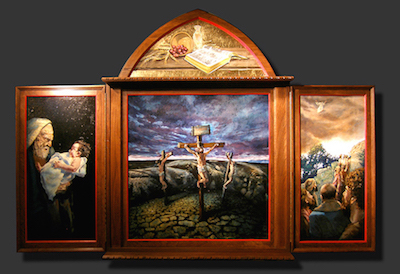
Our artists need invitations to serve. A culture of patronage would help to realize the creative potential of Confessional Lutheranism. To properly "invest" these creative blessings, there needs to be an atmosphere among us that values artists to the point of trusting them, engaging them, and paying them. Churches, schools, organizations and individuals can come to see artists as opportunities. Artists can bring unexpected solutions to stimulate our faith, educate our eyes, and communicate Jesus to future generations.
As products of a visual age, today's youth are especially suited to visual communication. Providing opportunities for today's creatives will only encourage more young people to apply their artistic talents to Gospel ministry. Let us wisely invest in our creative blessings that they may grow and spread in our time of grace and continue for generations.
For more images of Jaspersen commissions:
http://jjjaspersen.com
The Commercial / Liturgical Art Gap
by Jonathan Mayer,
from Seward, Nebraska USA
from Seward, Nebraska USA
More often than not, I find myself in the unenviable position of approaching my church with an artwork proposal. I'll presently explain the "unenviable" part, but for perspective, observe what usually happens when a person with some musical talent joins a Lutheran church of any size. Unless you're lucky enough to live in one of several parts of the country with a surplus of talented musicians, chances are good that this person will be politely inundated with requests to use his or her skills in the church. (My wife has experienced something to this effect.) And while musicians are not always paid well, Lutheran churches have little difficulty making use of their talents.
Compared to the plight of the Lutheran church musician, though, a Lutheran liturgical artist often finds himself in the position of having to peddle his services to churches. Artwork hasn't been viewed as a necessary component of our worship for the better part of a century. When I've approached my different home congregations in the past about commissioning liturgical art, I’ve detected the same sort of reaction that I would expect if I'd been a Cable TV salesman. It's seen as superfluous — possibly nice, but possibly wasteful — in any case, not worth a large investment of time and money.
My attempts to bring liturgical art into Lutheran churches have mostly been unsuccessful. If I were to discuss these at any length, it would start to sound like a pity-party. However, I've found that getting Lutheran churches interested in new graphic identities has met with greater success. I think examining the differences between a logo design and a physical work of liturgical art may be telling:
- Logos are everywhere — we're fluent in the language of commercialism. We readily understand the power of connecting an image with a product or service (branding), and we recognize the ability of a logo to convey immediately what we should expect from that product or service. Ironically, most of us are not fluent in the visual language of the Christian church — its symbolism, its stylistic idioms, or its power to convey meaning and embody beauty. Only a few generations removed from it, we often consider it alien ("too Catholic") and incomprehensible.
- Because we understand the power of graphic identities, we have at least some sense of their economic value. The same person who objects to paying $1,000 for a painting might not mind paying $1,000 for a well-designed logo. The difference is that a logo is more readily valued today for its utility; the painting is seen as merely decorative. (While this is a general observation, I've been blessed with clients who also appreciate art in an historical, liturgical setting.)
- In this high-speed, mass-produced, disposable culture, we don't often deal in terms of permanence. Our architectural solutions to worship are temporary; we assume that the space will be knocked down in 50 years when the drywall ceiling is too water-damaged to bother replacing, or when we've outgrown the space. (Or perhaps it will be converted into a gymnasium?) A graphic identity is impermanent, too — if we don't like it several years from now, we can change it or ditch it. No harm done. By contrast, a stained glass window may outlast the building it is installed in; a painting can last for a millennium if it is well maintained. Churches and works of art used to be made with longevity in mind. The artists were not making art for themselves, but for future generations of Christendom. Naturally, only their best would do.
For more images of Mayer commissions:
http://www.scapegoatstudio.com
What Does a Commission Do?
by William Bukowsi,
from Mankato, Minnesota USA
from Mankato, Minnesota USA
I received the commission to paint an altarpiece in 1995. The building committee and the Board of Regents from Bethany Lutheran College decided to have original artwork in their newly built chapel. I was asked to put together some ideas and sketches for how I envisioned this altarpiece. Naturally the life of Christ was the subject, and when closed, the altarpiece would show Bethany's motto, "The One Thing Needful." I presented my ideas to the Building Committee in the form of oil sketches and drawings and got permission to proceed.
A commission first of all is a sign of praising God. What a thrill it was to have this opportunity at the place where I work. We see the artwork every day in chapel and preachers often use it to illustrate homilies. It is especially moving to see the way the altarpiece is used in the Christmas service with the choir. Now, twenty years have passed since this altarpiece was installed and dedicated. How many students and faculty and staff have had their worship enhanced by the artwork?
A commission designates the beliefs of the people who use the sanctuary. In our image saturated culture, why not proclaim the glory of God? Or the life of Jesus? A blank wall does not say anything about our beliefs. Recently one of our visiting parents, upon walking into our chapel said, "Now I know I am in the right place!"
A commission is a collaboration between the congregation and the artist. The artist is empowered by the people commissioning the artwork. The congregation does need to be sensitive to the time and costs of labor and supplies. A typical attitude is that since it is for the church, it should be free or nearly free. A carefully designed work of art with premium materials will last many years. To create this altarpiece, I needed to secure models, costumes, have a cross built, and photograph all of my source materials. The canvas was Belgium linen with rabbit skin glue and oil priming white paint and the oils were all professional grade. So there was a considerable investment before I laid a pencil or brush to the project. When it is viewed, one cannot see the age of the artwork.
The results have been edifying the worship experience every day since.
I would welcome questions or comments about the possibilities of new art in the church.
For more images of Bukowski commissions:
http://www.bukowskipainting.com/commissions.html
For more on commissioning Lutheran Art:
http://www.lutheranart.com/
Translate this page into your language
Return to original language with "show original" button at top left.



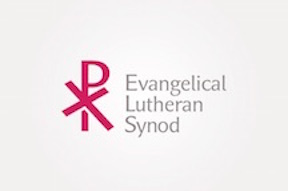


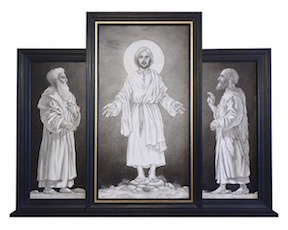
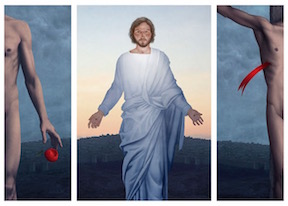


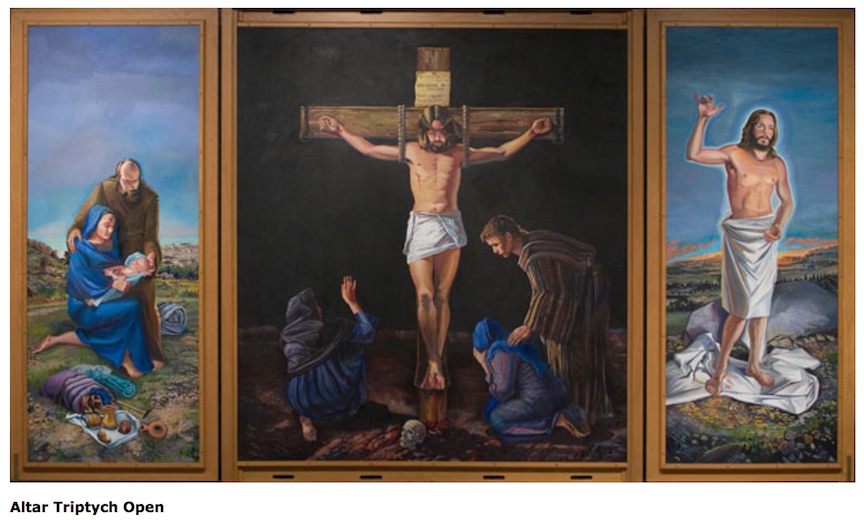
Discussion
It was powerful for me to see the panels in both the studio as well as installed in the chapel. The art needs to be ready for a formal setting even when it is not yet in a formal setting.
I love that a work of art as public as the Chapel altarpiece affects so many and for so long. This causes a variety of stories and relationships between the artist, art, and viewers. It becomes a shared experience.
I see this as an update on the Renaissance workshop. The primary focus is production. Apprentices would participate in production and learn whatever is necessary along the way. The result would be the rebirth of a system that produces art and artists-both uniquely appropriate for the Church.
I completely agree that as a church body we do not see the value of Christian art. I have recently been asked to serve on a decorating committee for church which is to provide and maintain the decor in the newly remodeled church narthex. The budget for the year is $100. This makes it incredibly difficult for us to do anything of substance. I'm not sure how we change this attitude that art for church has to be cheap but it's an attitude that needs to change.
I think there are assumptions of practicality and function that work against aesthetic decisions. Perhaps being frugal is not always good stewardship.
I also have come to the conclusion that offering prints of my existing illustrations and artwork provides an accessible way for individuals and churches to acquire my work. I'll be organizing and promoting that option more in the coming year.
I also offer temporary downloads for churches and schools to use for a season. That way the artwork can be incorporated into a design and printed/posted online for a specific function.
So...maybe a member who is an electrician can be expected to donate some time and expertise, but will you expect him to overhaul all the light fixtures and sound system for free? He may decide to donate his time and expertise, but I don't think it's right to expect that.
However, I see a difference between Joe electrician and myself, in that while his donated time is certainly nothing to sneer at (whether it's as a Sunday school teacher, a lawn mower, or handyman), his donated time is likely not taking away from his livelihood. Some artists have a teaching career to lean on; some artists are free-lance only, so any work done pro bono is food not set on the table. "For the Scripture says, 'You shall not muzzle an ox while it treads out the grain,' and, 'The laborer is worthy of his wages'" 1 Tim 5:18. Pastors especially seem to have a hard time with this concept. Their wages aren't hourly (or per sermon), and their income is virtually guaranteed for life. And while pastors do have a huge demand on their time, they probably won't have to wonder, "If I donate x hours this week, will I be able to pay rent?"
But, as Jason also said, having a supporting income doesn't remove all responsibility for payment. It really depends on the artist and the amount of work being asked for.
A permanent artwork is (usually) made with longevity in mind. In that case a congregation is making a decision that will affect the members for decades.
I will say that often the labor of the carpenters and electricians is also taken for granted when donated to the church.
I do see it as a vocation, but nobody has just one vocation. We hold many simultaneously, and the need to provide for one's family outweighs any special calling toward exclusively providing a certain kind of service.
I also think one of the best ways of getting the word out is just getting others excited about art! Obviously not everyone in the synod can come and take some art classes at Bethany and share in the same excitement I had while at Bethany, so how can we go out and find people in congregations who will get excited about art work in their churches too?
Could we instigate a Lutheran Art Revival by making use of the excitement surrounding the anniversary of the Reformation? Why not create a major event celebrating Lutheran art that reflects the ideals of the Reformation. Gather a bunch of artists together, display their work, get some hype built, and get the art work and excitement out there. Obviously the logistics of a big art show are difficult but the 500th Anniversary of the Reformation seems to be a pretty unique opportunity for something like this to be done. Maybe Christ in Media is a means for making something like this happen?
I understand also the perspective of someone like Jon (*NOT John--sorry about that typo earlier...) who relies on these images to pay the bills and put food on the table for the family--but there must be some work an artist like this would be willing to make public and share--to build awareness and to "tap the client base"...
Generally I've been pretty lenient with how the "Lamb of God" painting is used. Just about every week someone asks to use it on a poster, bulletin cover, or presentation. And for those uses, I don't ask for compensation. But when something gets plastered everywhere—it's devalued. It becomes just a part of the landscape, like so much branding that we see every day. That doesn't exactly accomplish the goal of building an appreciation of the arts. Furthermore, if something is "sacred", it is by definition set apart. I don't really think that making our coffee mugs resemble the artwork we use in worship is an end goal worth pursuing (even if royalties were resultant).
Does all "Liturgical Art" have to be "Sacred"? Are there various categories within Liturgical Art based on the artist's or piece's purpose? Also, how are we understanding "Worship"? I understand an altarpiece or stained glass windows primarily serves a purpose to enhance the Divine Service of Word and Sacrament in a "Corporate" Worship setting--certainly such a piece of art should be set apart as something special.. But in "worship" I would also include the daily devotion that I read on my phone. Or even when I take a moment to look at the details of a piece of Liturgical Art and consider the message it is sharing with me can also be devotional and (in a broad sense) "worship." As an artist, wouldn't this be a worthy goal? Aren't you trying to share a message as much as you can? Isn't this the nature of sharing the Gospel?
I am also trying to speak to Dr. Kuster's point about Outreach...When hostile unbelievers, outside of the church, see any liturgical art, chances are your work will be abused and maligned and sneered at. My encouragement would be to not let that bother you as an artist--as Christians the message we are sharing is going to be attacked--Jesus told us to expect that. I think the same thing goes for our Liturgical Art. I would encourage our artists to produce work that they are happy to share widely regardless... As a pastor, I think that is the point I'm attempting to make... I encourage you to put it out there as much as you can!
Jon, I sincerely appreciate and love your work. We are blessed to have your banners gracing our walls at Mt. Olive. And I appreciate your generosity in letting your work be used simply for Love of the Gospel. Let me ask you, other than for financial reasons (which we've already covered in this discussion) what are some other reasons why an artist would hesitate to let his work be widely shared? How do you try to keep the balance between something maintaining its value (being "sacred") vs. being devalued--becoming part of the landscape? Are pieces like the Sistine Chapel or Leonardo's Last Supper--devalued because I have a jigsaw puzzle of them? Or are they great works of art and Sacred because of the works themselves and the message they are sharing?
Obviously I am a fan of our Lutheran Art and of you artists, I wish I could use and promote your work more... As a pastor, I see opportunities where I'd love to show your pieces and talk about them and their meaning with people... But I also don't want to use your work in a way you would not approve of...I want to know how I can do this better showing you and your work the respect it deserves...
I think when it comes to classical works of art that are a familiar part of culture, they lose their power to communicate what was originally intended. Which, for sacred art, works against the purpose of making it widely available. They become so familiar that they have no further use to our culture than as vehicle for parody (i.e., meme fodder). For example, The Creation of Adam becomes the Flying Spaghetti Monster.
I see two main obstacles to Lutheran artists becoming household names. Firstly, I suspect that most artists who really feel called toward Christian subjects don't want to see their art taken less seriously because it has been marketed. And secondly, the kind of art that is marketable to the general public is usually safe, non-objectionable material: sunlit meadows, seaside cottages, sanitized country living. Place Jesus holding some lambs or children in any of those settings, and you have the limit of Christian subject matter that is also marketable. As you said, the unbelieving world is hostile to Christianity, and any art that faithfully represents Christianity can expect a similar treatment. That being said, I think we have little to fear in that regard so long as our work never finds its way onto throw blankets. :)
As an artist, I'm not picky which of those venues my work finds its audience in. "Messiah: The Greatest Sermon Ever Sung" is meant to be used as a devotional or Bible study tool. And some of those illustrations I've repurposed for an altarpiece design. And some have become banners, or have found their way across the internet. I suspect that any work of art that is beautiful and meaningful enough to merit a place in worship may also arrest the attention of someone perusing a book, or even browsing Facebook. If it causes reflection, curiosity, and possibly understanding, then I would be happy if it does that in just about any setting. (I say "just about" because of the above comments about work being devalued by its proliferation or its setting. Certainly a beautiful altarpiece would have a less spiritual impact if it was first encountered on a shower curtain.) The medium becomes part of the message (see Marshall McLuhan), and we have to understand how the work of art changes when it's seen in its physical location in a church, in a printed book, or on the web.
He Died For Our Sins – by Bukowski - http://fineartamerica.com/featured/he-died-for-our-sins-william-bukowski.html plus a virtual “trip” through the Trinity Chapel on https://www.blc.edu/trinity-chapel links to the chapel paintings with an explanation.
Christus Paradox Sand Animations – by Jasperson – is an artistic testimony of the work of Jesus http://jjjaspersen.com/portfolio/christus-paradox-sand-animations/
Illustrations of Handel’s Messiah – by Meyer – are visual testimony to what is called by Pittenger “the greatest sermon ever sung.” http://www.scapegoatstudio.com/illustration.html
It would take a major synod-wide event to get congregations even somewhat interested. Reception would be varied, of course, but I agree that it's a good place to start.
To me, it seems obvious that the only ones who appreciate the message of the gospel proclaimed in art are Christians—those people who recognize both their sin and their Savior. My job as a Christian and an artist is to share the gospel. I do that in my artwork to the extent possible, while recognizing that the Holy Spirit is found only where he has promised to be— in the Word and Sacrament.
Here it is. Do we give up? Or do we do these things well for once? Is it possible for God to use actors in a play to work faith in a heart? Can an installation artist have a valid, God-pleasing message? Does video have a place in the arsenal of today's Gospel effort? Maybe we Confessional Lutheran creatives need to join the battle for the souls of this time and place.
Is it really absurd to believe that non-old creative, expressive vehicles for ideas can have a God-pleasing effect on an unbelieving heart? I'm more hopeful than that.
Granted, artwork geared for outreach may lack the depth of insider artwork. But it's the same with hobbyist magazines, political parties, classic cars, and March Madness (probably going to be unfortunate comparisons, but I'll assume civilized readers). We in Confessional Lutheranism have varying degrees of involvement, knowledge and passion for what sets us apart, namely a proper distinction of Law and Gospel, Salvation by Grace Alone, Sacramental Worship, and the like. However we all know more than the general public about this (absolutely essential) sub-culture. We are insiders.
Some people who know and love classical music can have a conversation about the effects of Romanticism on Russian composers. Gear heads can debate the merits of different eras of the Corvette. Badger fans can get rabid about legendary moments. Comicon attendees might spar on who is the best Green Lantern. Insiders love to "talk shop".
If art is communication, can we use art to invite those outside the Church to come in, learn more, and eventually talk shop with us in heaven? It may actually have similarities to marketing (not a naughty word). It may actually be distilled (like the "great exchange" handouts). I would say in the case of outreach that is an appropriate way to use artistic gifts. And we creatives have a sizable void to fill.
"11 We have much to say about this, but it is hard to make it clear to you because you no longer try to understand. 12 In fact, though by this time you ought to be teachers, you need someone to teach you the elementary truths of God’s word all over again. You need milk, not solid food! 13 Anyone who lives on milk, being still an infant, is not acquainted with the teaching about righteousness. 14 But solid food is for the mature, who by constant use have trained themselves to distinguish good from evil."
Hebrews 5:11-14
Thanks for bringing up "insider speak." I had meant to tackle that at some point, but didn't find a place for it yet. I do think that's one of the obstacles to outreach with artwork. Christian art communicates in large part through symbols. But symbols communicate only to the initiated. If artists discard the canon of Christian symbolism to reach a wider audience, they may accomplish that end by inventing new symbols, but the result will be a more subjective artistic experience that may communicate any number of things. There's a trade-off.
As a graphic designer, I would say that simplicity is an asset. But there are times when I think there is more value in the beautiful and the mysterious than in the watered-down. We've all seen gospel tracts with cartoon stick people on them. What about something that is so beautiful, so intriguing, that a person would hesitate to throw it away? If they get it in the first 1.5 seconds, what is there to make them desire more?
I think about the Liturgical art we have from the past that is being shared with many people who have otherwise never set foot in a church or know about Jesus? Are Leonardo's Last Supper or Michelangelo's Sistine ceiling sharing a message with visitors and viewers? I would say, YES--even if the original context and setting of the work has changed from a worship space to a tourist destination (certainly the message isn't as strong...). In the same sense, aren't great pieces of music by Handel or Bach, etc. - that share a specific powerful Christian Message--still being shared in the public square because they are considered masterpieces? Will God be working even through this proclamation of His Word? (Does it even matter if not a single one of the performers is a Christian?)
I think a message is being shared, not because the artists originally intended to use it for the express purpose of Outreach--but the work and the message being carried in it is objectively beautiful, powerful, and good. I feel that if it is good art--opportunities will arise--where it will be shared! (i.e. Prof. Bukowski mentioned that the Trinity Chapel Altarpiece is 20 years old! Is there a plan to celebrate it's anniversary? We should try to build an event around it and call the local newspapers and news. We should invite the public to come and see the greatest piece of art in Southern Minnesota!)
Obviously I'm not advocating against educating people about the value of the art, but that education will be most easily realized with the object lesson of a beautiful piece of art in place. I strongly believe that it's a value that is impossible to ignore once it is seen, and maybe the biggest difficulty is just the first piece.
The idea of producing replicas is pretty common for fundraising and "building consensus". For my current bronze project, I painted an "artist's rendition" of the sculpture in place. The prints (of my painting) are considered gifts for those who donate above $100. We also considered having my scale models cast as higher level gifts, another common approach for sculpture. Replicas such as prints or miniature sculptures make it more financially realistic for individuals or organizations to "participate".
There should be a distinction made between limited editions and open editions. A limited edition assumes increasing value after the edition is sold out. With a limited edition materials such as paper, ink, matting, frames, UV glass are chosen for archival longevity. Artists usually hand sign and number a limited edition. All this attention contributes to a classy object that comes close to purchasing/owning original art. It also nurtures a feeling of collecting. WELS/ELS arts could get a boost if there were "collectors". Collectors turn into patrons. Patrons make art happen.
Open editions have none of these standards. Printing of an open edition can be on demand and on any material (tote bags, mugs, copier paper, bulletin covers, tshirts, etc.). This ends up looking a lot like licensing an image (Snoopy lunch boxes, Star Wars marker sets, etc.). Open editions allow for wide exposure of an image, but probably lose perceived value as the image is reproduced. Bill Watterson has resisted licensing Calvin and Hobbes for fear of it becoming something unintended. On the other hand, Dr. Seuss now has movies that rewrite his books.
The Christ in Media Institute has been a great help in hosting this conference and featuring this topic. Thanks much!
I have personally taken the approach that the market will drive things. Those who create what the market desires will create their own demand. In the movie "Gladiator" Maximus is encouraged to "win the crowd". For this reason, I have never applied for grants. I take responsibility for my output. If I'm not getting work, it's because I'm missing something. I put my energy into making work that speaks to the hearts of WELS/ELS people. Occasionally, I have jobs outside that realm and hope to make even those pieces relevant somehow to Confessional Lutherans.
Essentially, I'm staking my artistic career on the hope that the demand will emerge. So far, I've been just busy enough. Demand grows slowly and organically by word of mouth, return clients, and my diverse media. I have a trickle of illustration work, a trickle of sculpture work, a trickle of liturgical work, a trickle of motion graphics/animation...All combined, I have a steady stream. This arrangement is not workable for everyone. I have embraced this all-in-one approach. In making this choice, I have to sacrifice my depth in any of those areas. In an alternate reality in which I choose to specialize, I would be a much more masterful sculptor, or painter, or animator, or illustrator. So my development in all areas is slow and steady. God has blessed me with patience. I expect to be growing in all these areas for a lifetime. Mastery will come, but I'll have to wait. In the meantime, I can fill a lot of needs with passable quality.
We can't control others, only ourselves. Even that is suspect. God will grow this if it is his will.
We could use some visionary patrons with means. We need some "Medicis" in our midst to water this garden with commissions, training sabbaticals, prizes, and residencies. It's hard to imagine a sustainable WELS/ELS arts scene based on church budgets. Whether it's individuals or organizations that emerge doesn't matter much to me. I think that is a realistic step to explore.
But what if there was a lay artist in each congregation? Someone able to lead, educate, and explore the possibilities? Maybe the laws of economics don't exactly apply in the Body of Christ.
Patronage is looking to grow as well. MLC, BLC, and WLC all prominently feature Christian artwork that they have commissioned or purchased. As these organizations and their constituents realize the lasting value such artworks bring to campus, they set an example and endorse the idea of art. This will take generations to trickle down. "Early adopter" congregations and schools are starting to look at commissioning art to commemorate anniversaries and create a visual testimony.
With time, patronage and collectors may begin to resurface. Donations of art as memorial gifts, class gifts, and anniversary gifts may become more common. Congregations may begin looking to artists as they renovate. What if new building projects reserved 1% of their budget for the arts? Will a liturgical art center emerge to collect artists and craftsmen to provide consulting and authoritative liturgical art production? Or will we see thriving competition between "masters" and their followers? Will there be a WELS/ELS "style". Will there be "movements" in reaction to norms? Will we leave a visual message or will we just leave? Art has a peculiar power that God can use and bless for the furthering of his kingdom. Only He knows where we are heading.
The existence of this very forum is encouraging to me. Current communication methods help this effort. Social media, cell phone proliferation, user-based video publication, and social/technological developments allow us to share the Gospel widely and quickly. Historically, artistic styles were shaped by regional influences and traditions. Today we are unbounded by geography. Instead we collect our thoughts and influences online in groups of shared interests (like this forum). Momentum can be gathered on topics, like this, in a way unavailable to previous generations. Like the Greek language and Roman roads in the New Testament, and movable type in the Reformation, our new communication pathways require new thought and provide new opportunities. We'll need our all-knowing God to guide us in this uncharted territory.